Review/Reseña in A
Contracorriente | Vol. 6, No. 3. Spring 2009

Miniature Messages : The
Semiotics and Politics of Latin American Postage Stamps
Jack Child, Duke University Press, 2008
Hiding in plain sight –
the case for academic study of postage stamps
Review by Lincoln Cushing
This book makes the case for the legitimate study of a medium that receives little academic attention – postage stamps. Child explores these precious objects on several levels. At the most abstract, he looks at these documents through the analytic tool of semiotics – the study of signs and the messages they contain. He then offers a broad philatelic and political history of Latin American stamps, and eventually narrows down to detailed essays on the stamps from the Southern Cone, his region of expertise - Argentina, the Falklands/Malvinas, and territoriality on Antarctica. Childs’ expertise in both philately and Latin American history make this book both informative and provocative.
Given that stamps are high
profile, internationally distributed official visual documents it is
pretty obvious that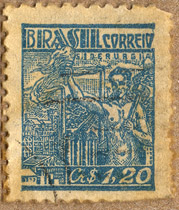 they constitute a form of propaganda. This is a medium for countries to
publish their story to the world, and in most cases the message – if
there is one - is banal. However, often stamps charge into
controversial topics, such as which country owns what piece of land, or
is the United States an imperialistic presence in Viet Nam. These
examples can take many visual forms, sometimes as subtle details such
as choice of colors, typographic placement, or which clothing a head of
state is shown wearing. Other examples are more overt - border lines on
a map, or celebration of key historic events, can be deliberately
challenging on the world stage. Child provides many wonderful examples
and anecdotes about such barbs. Even when visually innocuous, a
country’s stamp issuance proliferation has political overtones, as is
evidenced by Great Britain’s increased number of Falkland Island stamps
starting in the 1980s.
they constitute a form of propaganda. This is a medium for countries to
publish their story to the world, and in most cases the message – if
there is one - is banal. However, often stamps charge into
controversial topics, such as which country owns what piece of land, or
is the United States an imperialistic presence in Viet Nam. These
examples can take many visual forms, sometimes as subtle details such
as choice of colors, typographic placement, or which clothing a head of
state is shown wearing. Other examples are more overt - border lines on
a map, or celebration of key historic events, can be deliberately
challenging on the world stage. Child provides many wonderful examples
and anecdotes about such barbs. Even when visually innocuous, a
country’s stamp issuance proliferation has political overtones, as is
evidenced by Great Britain’s increased number of Falkland Island stamps
starting in the 1980s.
Of course, Child is not the first to note the political significance of postage stamps. "Stamp World" by A. B. Abraham was an occasional column in the World Magazine section of the Communist Party USA’s newspaper People’s World that ran for about ten years, beginning in 1977. Abraham used stamp images to explore such subjects as workers’ newspapers, liberation movements, sports, and black history. More recently, Agbenyega Adedze wrote “Commemorating the chief: the politics of postage stamps in West Africa” in African Arts (2004), Pauliina Raento and Stanley D. Brunn published “Visualizing Finland: Postage Stamps as Political Messengers” in the Swedish Society for Anthropology and Geography journal in 2005, and Geoffrey Swan et al. contributed “Licking Disability: Reflections on the Politics of Postage Stamps” in Radical History Review (2006). But Child takes on a geographic region and a call for legitimation that is a significant contribution to this scholarship.
Child makes a strong case for greater academic study of these documents by calling on semiotics (a relatively obscure term outside of academia used frequently in the text, but not defined until page 13). Similar consideration has been asked for political posters, their document cousins, and Child’s arguments (as well as his academic practice) are a welcome contribution to the broadening of scholarly genre. Some Latin American countries, perhaps most notably Mexico, take their stamps very seriously, to the extent that postal authorities there issue monographs on a range of philatelic subjects.
He also makes the unusual assertion that these be seen as government documents. Although this is an objectively obvious distinction, it’s not a common one, and offers stamps more gravitas than their perception as mere collectibles by amateurs.
His final assertion, that these
represent “popular culture,” is the weakest. He argues that they should
be 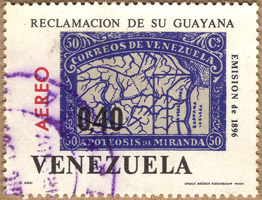 included in this genre because “they are seen and handled daily by
almost all adult citizens.” Although there are several different
definitions of this concept currently used by scholars, it’s usually
used to describe the opposite of “high culture.” The fact that stamps
are produced solely by the government, with little direct participation
by mass organizations, makes it hard to accept this definition. True,
they are intended to be commercially successful – no one will buy an
ugly stamp – but these are not comic books or t-shirts. The most likely
reason Child raises this proposal is to catch the new wave of
scholarship that is embracing fringier subject areas, which is a worthy
challenge. However, an approach that might be more defensible would be
to argue that stamps be seen as public art, like murals or
city sculptures.
included in this genre because “they are seen and handled daily by
almost all adult citizens.” Although there are several different
definitions of this concept currently used by scholars, it’s usually
used to describe the opposite of “high culture.” The fact that stamps
are produced solely by the government, with little direct participation
by mass organizations, makes it hard to accept this definition. True,
they are intended to be commercially successful – no one will buy an
ugly stamp – but these are not comic books or t-shirts. The most likely
reason Child raises this proposal is to catch the new wave of
scholarship that is embracing fringier subject areas, which is a worthy
challenge. However, an approach that might be more defensible would be
to argue that stamps be seen as public art, like murals or
city sculptures.
Child educates the non-philatelist about some of the complex and obscure dynamics in this genre. One major classification of stamps is between “definitive” stamps (the basic, generic, garden-variety stamps for basic postage) and “commemorative” stamps, those issued for a short period of time about topical or historical issues. These are invariably pretty and unusual, and thus attract sales by collectors. The significance of this cannot be underestimated, since stamps sold to the philatelic community will never be used for actual postage and thus constitute a significant income stream for the postal agency. However, Child never gives us a quantitative perspective on this commercial aspect of the stamp economy, and so it is hard to understand it’s true impact. Child does explore the tension between the stamp collecting world and the postal agencies regarding the issue of such eye candy; often it’s transparently clear that some stamps are generated solely to appeal to the collector market, which is frowned upon by serious philatelists.
The chapters on Argentina, the
Falkands/Malvinas, and the territorial claims in Antarctica are where
Child goes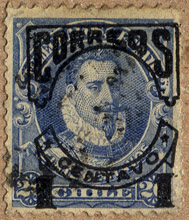 into considerable detail about the rich interplay between the stamps
issued and the political play behind the scenes. His scholarship
includes a detailed distribution of themes in Argentinean stamps over
the past 150 years.
into considerable detail about the rich interplay between the stamps
issued and the political play behind the scenes. His scholarship
includes a detailed distribution of themes in Argentinean stamps over
the past 150 years.
Although Child makes several references to stamps (mostly Mexican) that utilize the rich and nationally-referential imagery of murals, no mention is made of ones that are based on poster art. Stamps have been described as a miniature version of posters, with many similar design parameters. It is then not surprising that the Latin American country most famous for its poster art has also generated several stamps directly based on this tradition, most notably the designs of René Mederos Pazos. In 1969 Mederos was assigned by DOR (Department of Revolutionary Orientation) to travel to Vietnam to paint scenes of the war. He travelled to both North and South Vietnam along the Ho Chi Minh trail with the liberation forces, experiencing first-hand the brutal conditions of war and the courageous response of the Vietnamese people. The paintings were exhibited in Hanoi, and were subsequently reproduced as a screenprinted series which has been shown all over the world. Seven of these were issued in 1970 as postage stamps by the Cuban government.
Which brings us to the issue of images. Although there are 16 pages of very nice full-color plates reproducing 163 stamps, this subject is so inherently image-driven that many more referred to in the text are not displayed. One solution would have been to include black-and-white reproductions throughout the book as needed, which would have cost no more (beyond perhaps a higher page count) and would have placed the images in context with the essays. Instead, the author and his host academic institution (American University) have made available a CD of about 2,000 stamp images arranged in subfolders by country, along with PowerPoint presentations and other documentation. The image resolutions range considerably, and none of them allow enlargement for closer examination (alas, because many stamps have subtle details that merit close inspection), but they are useful as reference shots.
The legal issues concerning these images as government documents are fascinating. Child points out that in most of the world, these are considered public domain images, yet the United States is one of the few countries where a government agency became “quasi-governmental” in 1978, with a substantial ancillary commercial products division. The consequences of this have been to render stamp images strictly controlled by copyright. (This privatization also includes art in post office buildings, a development that has stymied scholars of 1930s-vintage public works murals and sculptures). However, Child sticks up for fair use and the miracles of digital imaging, and has gone the extra distance to assist research by sharing through the available CD.
Although this book is
relatively balanced in its treatment of the enormous political range
reflected in the stamps,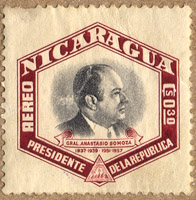 Child singles out
postrevolutionary Cuba for critical treatment. Italicized passages are
by this reviewer:
Child singles out
postrevolutionary Cuba for critical treatment. Italicized passages are
by this reviewer:
“The availability of large numbers of stamps coming from Cuba, and the pro-revolution themes they carry, make them more than a little suspect, as they provide pure profits in hard currency to the Castro regime, as well as deliver a propaganda message.” [p. 34]
“Although many, if not most, of these [Cuban] stamps were issued primarily for collectors, it is also true that they present a many-faceted visual compendium of the things that the revolutionary government felt were important.” [p. 79]
“Particularly virulent was a 1966 series of stamps titled “Genocide in Vietnam” (Scott 1163-1165). U.S. aircraft were depicted dropping bombs, followed by stamps showing the ensuing casualties (mainly women, children, cattle). Some victims were shown with gas masks, suggesting that the United States was using chemical or biological weapons. [p. 80, stamp not in book or on CD]
“Cuban stamps, like those of the Soviet Union, include significant numbers of issues devoted to art, culture, animals, natural attractions, and tourism, making them somewhat suspect as postally valid issues, since many of these stamps are in large formats, brightly colored, and apparently intended for the collector’s market rather than actual postal use. [p. 174]
These critical statements are a bit puzzling, since he offers no examples or data to support them. For example, undermining his own argument about the collector’s market, he points out that the U.S. government has made it illegal for citizens to purchase these stamps since 1963 (the only other Latin American country thus embargoed being post-Sandinista Nicaragua). He also offers numerous examples of other countries that crank out embarrassingly commercial stamps of sports they don’t play, animals they don’t have, and events that have nothing to do with them.
Child barely explores the rich
philatelic and political connection between Cuba and Viet Nam. For
example,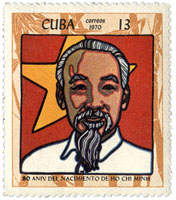 because the long series of wars for national liberation had destroyed
much of the industrial base, Cuba helped out, and most Vietnamese
stamps issued between 1983 and 1990 were printed in Havana.
because the long series of wars for national liberation had destroyed
much of the industrial base, Cuba helped out, and most Vietnamese
stamps issued between 1983 and 1990 were printed in Havana.
The claim by the United States that Cuba is a rogue philatelic nation is not a new one.
“The issue of postage stamps of the Republic of Cuba by authority of the Provisional Government has aroused the ire of the philatelists and the dealers in stamps in this country, who assert that the stamps have been issued for purely speculative purposes.”
This complaint is from an article in the New York Times, March 22, 1896, two years before the United States hijacked their war of independence.
Despite this blind spot, Child’s book is a significant contribution to the argument that academia should expand subject legitimacy to a broader range of materials. It’s also got great stories about the complex world of Latin American politics and the role of government propaganda.
All stamps illustrating this review from author's own collection.
Return to Docs Populi / Documents
for the Public
updated 4/23/2021